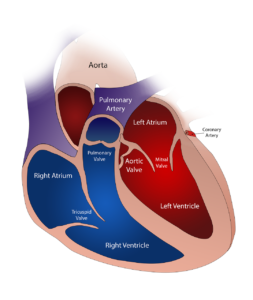
Divisions in the Heart – Part Two
 In one way, we can think about the heart with a cross superimposed upon it. The upper portion of the heart is the two atriums or areas of rest. The lower portion is two ventricles, the area of work. Consider, also, the right side of the heart which handles the “venous blood” which is low in oxygen, and is under low-pressure. The left side of the heart handles the “arterial blood,” oxygenated blood which has pressure high enough to reach all parts of the body.
In one way, we can think about the heart with a cross superimposed upon it. The upper portion of the heart is the two atriums or areas of rest. The lower portion is two ventricles, the area of work. Consider, also, the right side of the heart which handles the “venous blood” which is low in oxygen, and is under low-pressure. The left side of the heart handles the “arterial blood,” oxygenated blood which has pressure high enough to reach all parts of the body.
In Romans 10, St. Paul has been writing about his Jewish brothers and sisters. He mentions the word “heart” four times in this chapter and begins by expressing that it is his “heart’s desire, and my prayer to God for them is for their salvation.” (Romans 10:1b). An analogy might be that St. Paul represents a good strong “left ventricle” Christian. His desire to have his fellow Jews believe in Christ is filled with energy and compassion. It is ready to go out and share Christ with others.
But as St. Paul many times shared Jesus with his fellow Jews, some believed; many did not. In Romans 10 Paul quotes some passages from the Exodus. Paraphrasing him, I suggest that he says, “Don’t think that you have to go up to heaven to bring Jesus down, or to go down to the place of death and bring Him up.” Jesus came from heaven because of His love for us. And He rose from the dead because it was “impossible for death to hold Him.” (Acts 2:24). St. Paul is criticizing his Jewish brethren for wanting to do the work of bringing God into their lives on their terms. God does the work. But Paul and God’s “Body” (the Church), cooperate in this communication of life.
One of the interesting things about our heart is that the upper chambers/atriums have two of the sensors which help determine how hard the heart pumps. They are both called “conducting tissue” because they conduct impulses that determine contraction strength. The upper portion of the heart does not have nerve cells which communicate contraction. Instead, the special muscle in the heart itself communicates throughout the atria when and how much to contract. The SA node is sometimes called “the pacemaker of the heart.” Interestingly, the SA node controls only the atrium, and a special layer between the upper and lower portions of the heart — like a horizontal cross-beam — prevents conduction to the lower portion. We cannot dictate who comes to faith.
The AV node, also located in the right atrium, the low-pressure zone, serves primarily the lower portion of the ventricles, where the heavy pumping happens. Unlike the SA node, the AV node does have special conductive nerve-like qualities which descend vertically down to the ventricles. This special tissue conducts impulses six times as fast as the heart muscle tissue above. It times its impulse to the ventricles with a slight delay, so that the atriums have enough time to pump blood to the lower chambers. But both of these nodes actually take their direction not only from the local environment but also from the brain. There is an obvious reason why Christ is called “The Head of the Church,” (Ephesians 2:1). He’s in charge of descending into hearts and souls.
There is amazing coordination in the heart among what’s going on locally, what’s going on throughout the body chemically, temperature and oxygen consumption, blood pressure, and the “cardiovascular center” in the base of the brain. The cardiovascular center in the medulla can even alter the muscle tone around blood vessels to change pressure as needed! God uses personal burdens and blessings as the “local environment” in people’s lives to open a heart to Him. He can orchestrate all of these elements at once.
Like Paul, our “hearts desire” should fervently be to bring Christ to those who do not know Him. But Christ is our Head-Heart Center. He works perfectly through time and situations, to use us to conduct faith as we accept His grace, our limitations, and heed His direction. We cannot force faith, but we can prohibit conduction of Christ by keeping our hearts and mouths closed to others. We do “read” the environment as we share Christ, but ultimately we seek the Lord’s direction and trust the Holy Spirit to bring people to faith.
Prayer: Lord, like the sensors in the heart, we often are in an environment of low spiritual pressure, even apathy. A task You have given us is to share You with others. We are part of the conductive tissue of Your heart, Your love for the world. Help us to trust our “Head” and seek His Word and blessing upon our transmission of the message of life. In Your Name, Amen.
